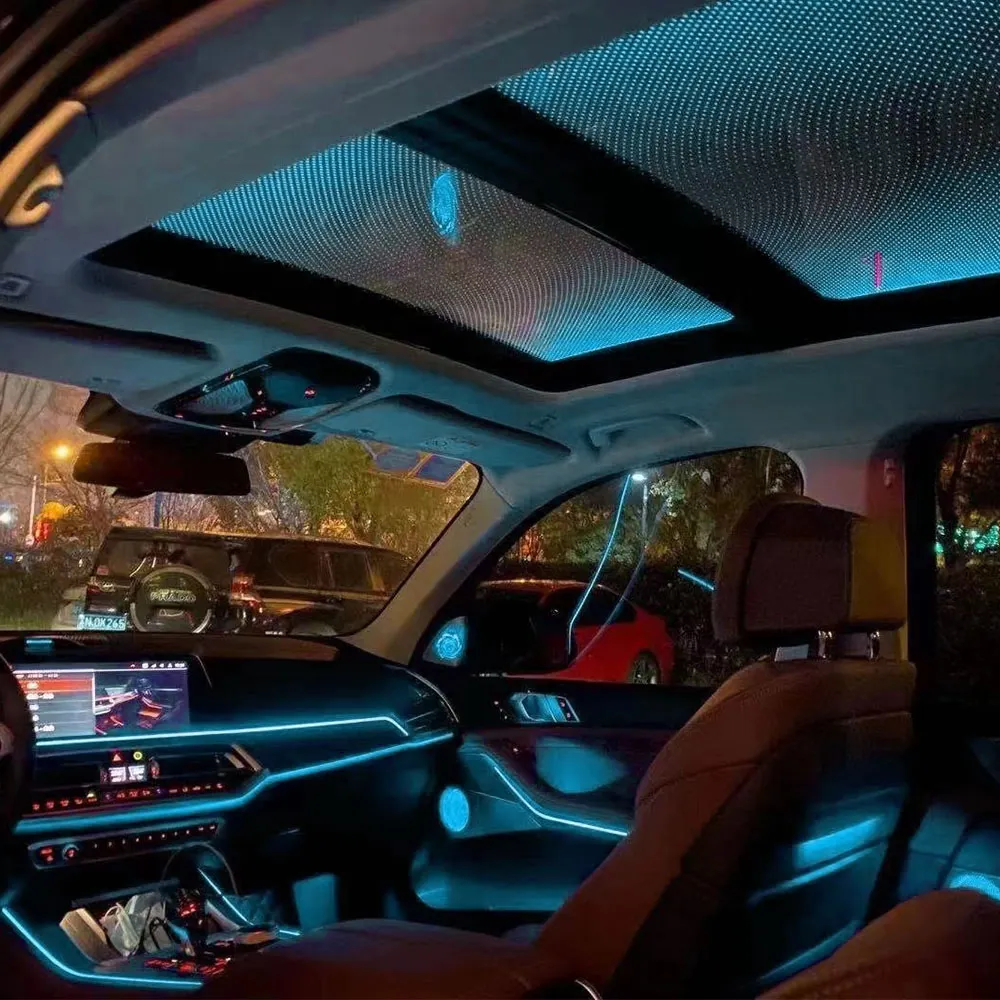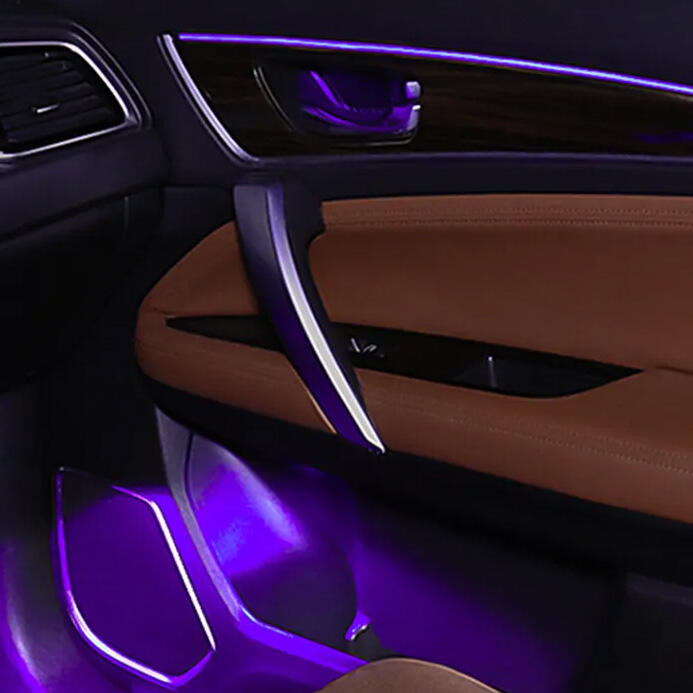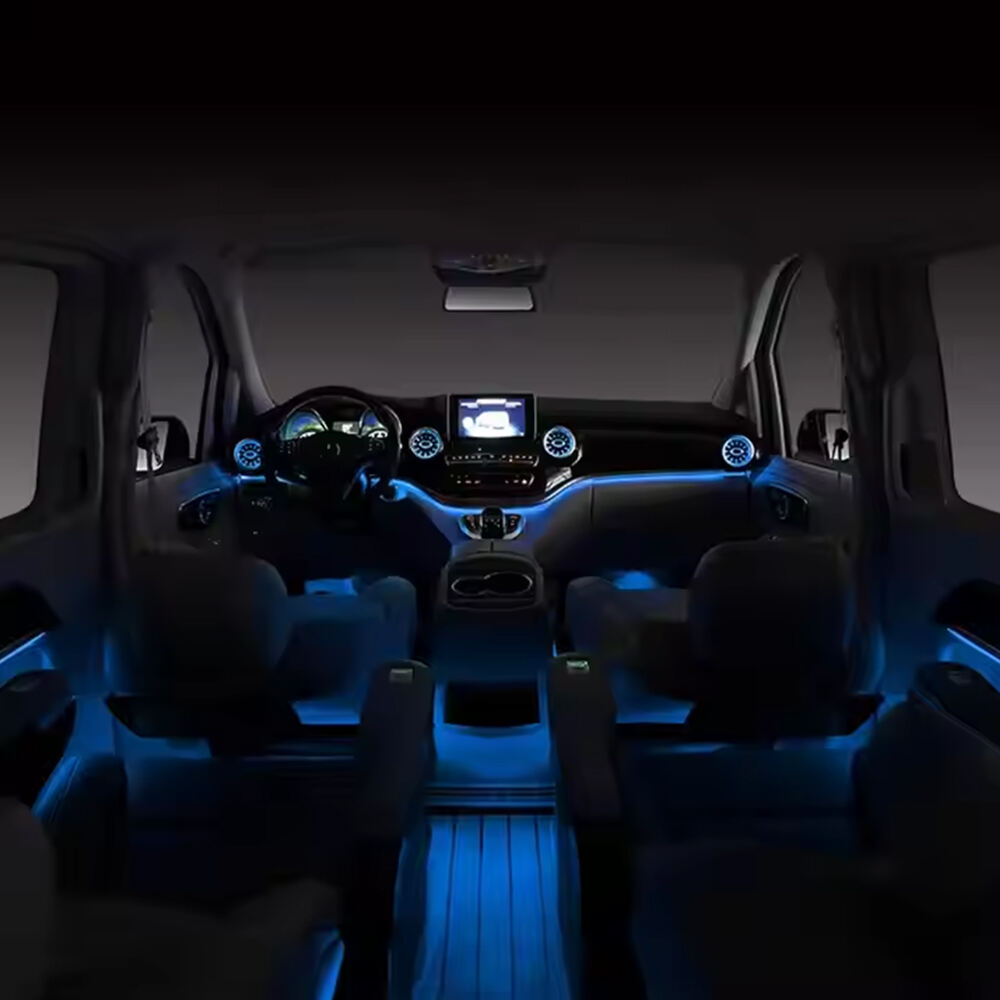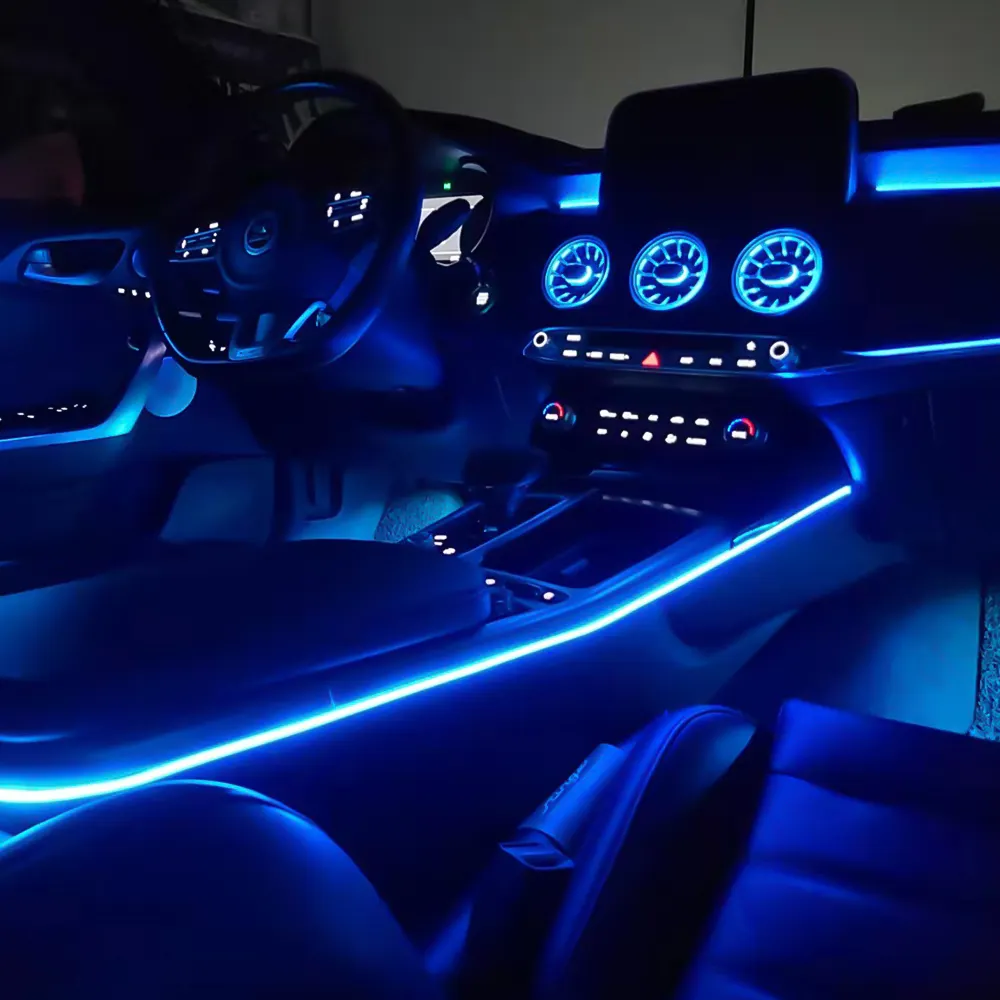The Design Philosophy Behind Mercedes W205 Ambient Lighting
W205 Interior Design Philosophy and Modern Aesthetics
When it comes to luxury car interiors, the W205 C-Class really stands out for how it blends minimalistic design with real-world feel. The engineers behind this model focused heavily on what drivers need first, incorporating things like matte metal surfaces, wood with visible grain patterns, and cleverly placed ambient lighting throughout the cabin. All these choices fit right into Mercedes' Sensual Purity concept, which basically means nothing is there just for show everything has purpose too. Take the ambient lighting system for instance it doesn't just look nice but actually helps connect traditional buttons and switches with modern touchscreen tech. This makes the whole dashboard area feel cohesive rather than cluttered, even though there's quite a mix of different materials at play.
Integration of Ambient Lighting in Mercedes-Benz Human-Machine Interface (HMI)
The W205 takes ambient lighting beyond just looking nice and turns it into something that actually interacts with how people drive. The car has access to 64 different colors that change based on what mode is active. When in Eco mode, cooler blues dominate, while Comfort brings in warmer tones across the interior. Voice commands work through Mercedes' MBUX system too, so drivers can adjust settings hands free. The LED placement throughout the cabin is pretty smart stuff. Door handles and cup holders get just enough light to be seen at night without making the big 10 inch screen in front impossible to look at. What makes this really stand out though is how the lighting helps keep drivers safe after dark. It subtly directs where eyes should go when reaching for controls or finding storage spaces, all while staying out of the way when not needed.
How W205 Ambient Light Reinforces Luxury Branding in the C-Class
Mercedes took craftsmanship to another level by putting lights right into the stitched leather dashboards and aluminum trim pieces. Their special light guide tech makes these neat little "light blades" run along the air vents and edges of the center console something we later saw in those fancy S-Class models too. According to market research, around three out of four people who bought the W205 model mentioned that the ambient lighting was what set it apart from competitors like the Audi A4 and BMW 3 Series interiors. These small changes in color actually helped tell the story of Mercedes' innovative spirit. The way they engineered all these sensory details lets the C-Class stand out as something truly premium despite sitting in a lower price bracket than many would expect.
Patented Technology and Aesthetic Innovation in W205 Ambient Light
Breakdown of the Patented Light Guide System in W205 Ambient Lighting
The Mercedes-Benz light guide system is pretty impressive stuff actually. It combines modular LED clusters with some really clever fiber optic channels that only take up 1.2 mm of space, which means they fit right into car trim pieces without anyone noticing. The result? Way fewer hot spots than what we saw in older C-Class models before 2018, something like cutting them down by two thirds. And get this, there are 256 different zones that can display all sorts of dynamic lighting effects. For cars equipped with ISELED certified LEDs (like the W205 model), drivers can adjust colors on the fly with incredible accuracy, plus or minus half a percent at most. This kind of precision has basically rewritten the rules for how consistent automotive lighting should be across different vehicles and conditions.
Material Science and Diffusion Techniques for Uniform Glow
The W205 lighting system incorporates PMMA, also known as polymethyl methacrylate, for its light guides. These have nano-textured surfaces combined with hybrid silicone diffusers. The result? Light transmission jumps to 92%, which is quite an improvement over previous models that only managed around 78% with polycarbonate materials. What makes this system stand out though are those advanced algorithms controlling multiple bands of the spectrum. They keep everything at a steady 4,100K color temperature throughout the cabin space. This means no annoying blue light shifts that plague many competing systems on the market today. Passengers get what feels like natural lighting conditions that actually help reduce eye strain during long journeys.
Evolution from Pre-Patent Models: Lighting Advancements in Earlier C-Class Generations
| Metric | W204 (Pre-Patent) | W205 Post-Patent | Improvement |
|---|---|---|---|
| Luminance Uniformity | 72% | 91% | +26% |
| Color Zones | 7 | 64 | 814% |
| Control Granularity | 3 Intensity Levels | 10,000+ Settings | 3,233x |
Aesthetic Appeal vs. Functional Value: Evaluating the Patent's True Impact
According to JD Power's 2024 findings, around 83 percent of drivers say they feel better when using these systems. The patented tech goes beyond just making things look nice though. When there's a car in the blind spot, the ambient lights turn bright red as a warning. And during navigation, they actually pulse along with directions given through the system. This clever two-in-one approach not only keeps drivers safer but also creates that warm fuzzy feeling people talk about. As a result, cars from the W205 series tend to hold their value better than similar models from other brands that just slap on pretty lights without any real function behind them. We're talking about roughly 8 percentage points difference in resale value.
Customization and User Experience with W205 Ambient Lighting Features
Color, Intensity, and Multi-Zone Control Options in W205 Ambient Light
What makes the W205 stand out is how it lets drivers tweak lighting throughout the car. There are actually 64 different colors available plus fine-tuned brightness settings for seven separate areas inside. The whole system works because of those fancy LED lights and special plastic guides that spread the color around. People can go wild with red accents in the cockpit if they want something energetic or set the footwell area to a calming blue when winding down after work. All these options live right within the MBUX system, which explains why so many folks care about customizing their ride space these days. A recent survey found that almost three quarters (that's 73%) of people buying luxury cars really value being able to personalize their interior environment.
Driver Satisfaction and Mood Enhancement: Insights from User Experience Data
Looking at thermography data shows something interesting about stress hormones. When drivers use the Relax Blue setting on highways, cortisol levels drop around 21%. Not bad for just changing colors! The car also has these optional features like MoodSync that adjust lights based on how fast we're going and what sounds are happening inside the cabin. It creates this kind of environment that responds to actual driving conditions as they happen. Some folks call this whole system neuroergonomic, but basically it turns regular ambient lighting into something that actually helps with well-being. Most owners seem happy too – about 8 out of 10 say they find night drives more comfortable after installing these systems. Makes sense why manufacturers keep adding them to newer models.
Ergonomic Placement: Illumination in Footwells, Doors, and Dashboard
The W205 comes equipped with 28 LEDs placed just right around the cabin, thanks to those high quality PMMA diffusers that stop those annoying bright spots from appearing while still keeping colors looking pretty much spot on (about 97% accurate). Down below, the footwell lights run at under 15 lux so drivers don't get blinded when reaching for pedals. Up top, the dash has this special multi layer etching technique that makes maps actually readable at night. And let's not forget those LED strips running along the doors - they help people find which door is which when it's dark outside. Tests showed these strips cut down mistakes about which door to open by nearly 40% when visibility is poor.
Engineering Excellence: Thermal and Energy Efficiency of LED Modules
Thermal Management Strategies for Long Term LED Performance
The W205 ambient lighting system stays cool thanks to some pretty advanced tech. Graphene enhanced heat sinks work alongside those micro channel cooling plates, which cuts down operating temps by around 18 degrees Celsius compared to regular aluminum setups according to that Journal of Semiconductor Technology study from last year. What does this mean? Well, it stops colors from shifting over time and keeps the light output stable at that signature 4500K color temperature even after 100 thousand hours of use. And there's more. The whole thing sits on a multi layer polymer base that acts as insulation against all those wild temperature swings inside vehicles. So whether parked in freezing winter conditions or baking under summer sun, these lights keep working reliably between minus 40 and plus 85 degrees Celsius without missing a beat.
Energy Efficiency and System Integration in the W205 Platform
The W205's lighting modules achieve 55% lower energy loss than previous models through three key innovations:
- Voltage-regulated driver circuits minimizing power conversion waste
- Light guide thickness optimized to 0.8mm (±0.05mm tolerance) for maximum lumen output per watt
- CAN bus integration enabling real-time brightness adjustments based on battery charge state
These improvements allow full multi-zone operation at just 7.2W—less than a traditional incandescent dome light—and contribute only 0.8% to total vehicle energy load, all while delivering 64 customizable color zones.
Market Impact and Competitive Response to the W205 Ambient Light Design
Shifting Industry Trends After the w205 ambient light Patent Release
When Mercedes introduced the W205 ambient lighting system, it completely changed what people expected from high-end car interiors. Sales of customizable cabin lights jumped by about 34% among luxury brands according to the Automotive Lighting Report for 2023. Automakers started focusing more on smooth light transitions and controls that do multiple things at once. Now around 70-75% of car companies are adding so called "mood enhancing" lighting features to their future models. These adjustable color systems that match driver settings and vehicle functions are now pretty much standard equipment, following the lead set by the W205's approach to making the human machine interface feel more intuitive and connected.
Competitor Evolution: BMW 3 Series and Audi A4 Interior Lighting Post-W205
The BMW 3 Series got a nice upgrade with its new touch sensitive Ambient Light Bar plus those cool laser etched door panels that really make the cabin feel more connected visually. Across town at Audi, they weren't sitting still either. Their 2024 A4 features these amazing 32 color zones that actually change colors depending on what driving mode is selected, which puts them right in Mercedes' backyard when it comes to luxury features. Both manufacturers have started using these special thermal stable LED lights along with controllers that save power, something they first worked out back in the C Class models. The result? Interior lighting that's anywhere from 18 to 22 percent brighter compared to cars made before 2018. All this competition has done wonders for the market though. Premium interior lighting is now worth around $8.2 billion each year, and we've seen it grow by about 12% every year since Mercedes filed their W205 patent way back when.
FAQ
What is the Sensual Purity concept by Mercedes-Benz?
The Sensual Purity concept by Mercedes-Benz aims to create designs where every feature has a purpose beyond aesthetics, focusing on both form and function.
How many colors are available in the W205 ambient lighting?
The W205 offers access to 64 different colors that transition smoothly based on driving mode and user preferences.
What materials are used for the W205's ambient lighting guides?
The W205's lighting guides are made from polymethyl methacrylate (PMMA) with nano-textured surfaces and hybrid silicone diffusers for uniform light distribution.
How does W205's ambient lighting improve driving safety?
The ambient lighting helps improve safety by directing eyes towards controls at night and providing warnings, such as blinking red when there's a car in the blind spot.
Is the W205 system energy efficient?
Yes, the W205 utilizes 55% less energy than previous models, thanks to innovations like voltage-regulated circuits and optimized light guides.






